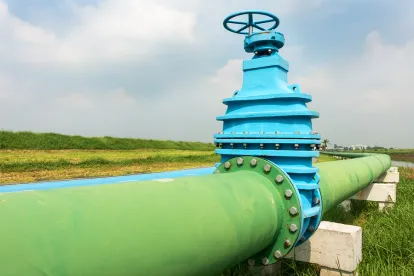PHMSA Announces User Fee Rate Structure for Underground Natural Gas Storage Facilities
On April 6, the Pipeline and Hazardous Materials Safety Administration (PHMSA) issued a Notice announcing the user fee rate structure that will apply to operators of underground natural gas storage facilities during fiscal year 2017 if Congress appropriates funds that were authorized under section 2 of the Protecting Our Infrastructure of Pipelines and Enhancing Safety Act of 2016 (PIPES Act). The fees will fund safety oversight activities of PHMSA and state regulators at storage facilities and will be based on the amount of each operator’s working gas capacity at both active and inactive fields, as reported to the Energy Information Administration. PHMSA states that, in future years, the fee will be assessed based on the number of wells at a facility. The Notice also responds to comments received on PHMSA’s November 7, 2016 Notice announcing a proposed user fee rate structure.
PHMSA Issues Advisory Bulletin Reminding Gas Transmission Operators to Establish Qualification Requirements for IM Personnel
On April 10, PHMSA issued an advisory bulletin reminding gas transmission pipeline operators that supervisory and other personnel responsible for integrity management (IM) activities must have appropriate training or experience to be considered qualified to perform those tasks. IM programs must include qualification criteria for supervisory personnel and personnel who perform assessments and evaluate results and who are responsible for preventive and mitigative measures. The advisory bulletin describes PHMSA’s expectations for implementing training and qualification requirements and states that the advisory bulletin will inform evaluations of IM programs.
PHMSA Issues Advisory Bulletin Regarding Deactivation of Threats Under Gas Transmission IM Programs
On March 16, PHMSA issued an advisory bulletin providing guidance for determining the active or inactive status of threats under gas transmission IM programs. The advisory bulletin states that IM regulations do not provide for the permanent elimination of the nine threat categories identified in ASME B31.8S, which is incorporated by reference into PHMSA’s IM regulations. Operators must continually re-analyze the status of all threats through operation and maintenance and information integration activities. The advisory provides guidance for determining whether a threat is active or inactive, and emphasizes that a threat must be considered active if any data identified in Appendix A of ASME B31.8S is missing. Operators also must document determinations that a threat status is inactive.
PHMSA’s Interim Final Rule Adopting Safety Standards for Underground Natural Gas Storage Facilities Is Challenged at Courts of Appeals
The State of Texas, American Gas Association (AGA) and Interstate Natural Gas Association of America (INGAA) have filed separate petitions for review of PHMSA’s interim final rule adopting federal safety regulations and reporting requirements for underground natural gas storage facilities. The petition of the State of Texas (No. 17-60189) is pending at the U.S. Court of Appeals for the Fifth Circuit. The petitions of AGA and INGAA (Nos. 17-1095 and 17-1096) are pending at the D.C. Circuit Court of Appeals where they have been consolidated for consideration. All three petitions will likely be consolidated, but it is not clear which court will hear the case.
PHMSA Rulemakings Update. The tables below summarize the status of PHMSA’s rulemakings as reported in the Department of Transportation’s (DOT) December Significant Rulemaking Report, and by the Office of Management and Budget's (OMB) Office of Information and Regulatory Affairs (OIRA) in the Fall 2016 Unified Regulatory Agenda. DOT has not released a Significant Rulemaking Report since December because rulemakings are subject to evaluation in accordance with Executive Orders 13771 and 13777.
Under Executive Order (EO) 12866, OMB reviews proposed significant rules to ensure they are consistent with applicable law, the President’s priorities, and the principles set forth in the EO, and to ensure the proposals do not conflict with another agency’s policies or actions. OMB also analyzes the cost-benefit analyses in support of the proposals. While the EO sets out deadlines for OMB evaluation, review periods are often extended.
Pending Final Rules
|
Proceeding |
DOT Estimated Submission to OMB |
DOT Estimated Publication |
OIRA Estimated Publication |
|
Enhanced Emergency Order Procedures (Interim Final Rule issued October 2016) |
Not listed |
Not listed |
No estimate provided |
|
Inflation Adjustment of Maximum Civil Penalties (Interim Final Rule issued July 2016) |
Not listed |
Not listed |
February 2017 |
|
Plastic Pipe Rule (NPRM issued May 2015) |
Not listed |
Not listed |
December 2016 |
|
Safety of Gas Transmission and Gathering Pipelines (NPRM issued April 2016) |
August 29, 2017 |
December 11, 2017 |
Not Listed |
|
Safety of Hazardous Liquid Pipelines (NPRM issued October 2015) |
Advanced copy released January 13; withdrawn from publication in the Federal Register on January 24, 2017. |
||
Pending Notices of Proposed Rulemaking
|
Proceeding |
DOT Estimated Submission to OMB |
DOT Estimated Publication |
OIRA Estimated Publication |
|
Standards Update Rule – 2015 and Beyond (formerly the “Periodic Updates of Regulatory References to Technical Standards and Miscellaneous Amendments”) |
Not listed |
Not listed |
November 2016 |
|
State Pipeline Safety Program Certification |
Not listed |
Not listed |
November 2016 |
|
Valve Installation and Minimum Rupture Detection Standards |
January 24, 2017 |
May 3, 2017 |
May 2017 |
OTHER PHMSA UPDATES
PHMSA updates information about state excavation damage prevention law enforcement programs. PHMSA continues to post information about its evaluations of state excavation damage prevention law enforcement programs, including FAQs and determinations of adequacy for individual states. A July 2015 final rule established a process for (1) evaluating state excavation damage prevention law enforcement programs and (2) enforcing minimum federal damage prevention standards in states found to have inadequate enforcement. PHMSA has posted letters that were sent to 27 states regarding the adequacy of their enforcement of damage prevention laws. Ten states (Alabama, Alaska, California, Colorado, Delaware, Idaho, Mississippi, Montana, West Virginia, and Wisconsin) have been notified that their damage prevention programs are inadequate.
UPDATES FROM OTHER FEDERAL AGENCIES
Ms. Bella Dinh-Zarr becomes Chair of NTSB. Effective March 15, Christopher A. Hart’s term as Chairman of the National Transportation Safety Board (NTSB) concluded. Vice Chairman Bella Dinh‐Zarr will serve as the agency’s acting chairman until a new chair is selected and confirmed by the Senate. Mr. Hart will remain on the NTSB board.
UPDATES FROM INDUSTRY
Common Ground Alliance updates Guide to Best Practices for Damage Prevention. CGA has published Best Practices 14.0: The Definitive Guide for Underground Safety and Damage Prevention. The new edition includes a new practice for providing a monitor during pipeline excavations and modifications to practices addressing Markers for Underground Facilities and Structured Education Programs.
PIPA Publishes New Excavation Safety Guide. The Pipeline Association for Public Awareness (PIPA) published its 2017 Excavation Safety Guide and Directory. This issue addresses abandoned pipelines, private utility locating, ground penetrating radar, marking practices, the Gold Shovel Standard, power line safety, cross bores, and a directory of state regulators and pipeline operators.
SELECT UPDATES FROM STATES
CALIFORNIA
On February 9, the California Office of the State Fire Marshal’s new regulations implementing annual inspections of intrastate hazardous liquid pipelines and operators of such facilities and establishing new annual reporting requirements became effective.
FLORIDA
Effective March 2, the Florida Public Service Commission adopted a number of amendments to its gas pipeline safety regulations including provisions to adopt the 2016 version of federal standards pertaining to reporting requirements, safety standards, and drug and alcohol reporting standards, and to adopt other clarifying amendments pertaining to, among other things, visual inspections, maximum allowable operating pressure, corrosion, valves, welder qualifications, leak detection surveys, and inspections and monitoring.
MASSACHUSETTS
On February 15, the Massachusetts Department of Public Utilities issued an order adopting numerous amendments to its pipeline safety regulations. The amendments were intended to clarify the regulations, update statutory references, and align civil penalty caps with federal limits.
MONTANA
HB 365 (Shaw). Proposed HB 365 would, among other things, revise laws regarding excavations near underground facilities, establish an Underground Facility Protection Advisory Council (Council), define duties of the Council and the Department of Labor and Industry (Department), grant the Department rulemaking authority, authorize the Department to collect fees, fines, and civil penalties, establish civil penalties, require the reporting of incidents, and establish safe excavation requirements. The bill was referred to the House Committee on Energy and Telecommunications.
NEW MEXICO
SB 303 (Martinez). Effective July 1, SB 303 increases the civil penalty cap for pipeline safety violations from $25,000 to $100,000 for each violation per day to a maximum of $1,000,000 for any related series of violations.
NEW YORK
A2320 (Dinowitz). This bill would require each gas corporation to file an annual gas safety report with the New York Department of Public Service (NYDPS). The report would describe the company’s methodology prioritizing pipeline replacement projects, operation and maintenance activities related to gas safety, and describe inspection policies relating to pipeline infrastructure. The report would also include a list of pipeline replacement projects completed within the last year and indicate which were completed by employees and which were completed by contractors. The NYDPS would be required to notify the New York Public Service Commission (NYPSC) of any deficiencies in a gas corporation’s prioritization of projects or administration of its infrastructure. The bill passed the Assembly and was delivered to the Senate on March 28.
A3621 (Dinowitz). This bill would require operators of underground facilities to notify the NYDPS of incidents involving damage to underground facilities. Within 60 days, the NYDPS would be required to post on its website whether the incident will be investigated. The bill was introduced in January and was reported to the Ways and Means Committee.
A467 (Paulin). This bill would require that the NYDPS adopt the classification system for natural gas leaks described in the statute; require gas companies to report annually to the NYDPS the location and classification of each leak, the date classified, and date repaired; and require that the NYPSC investigate the need for additional winter surveillance of cast iron and ductile iron pipelines due to extended frost cap conditions. The bill has passed the Assembly and was delivered to the Senate on March 29. It has been referred to the Senate Committee on Energy and Telecommunications.
OREGON
HB 2889 (Sponsored by the Committee on Veterans and Emergency Preparedness). This bill would establish a Task Force on Secure Pipelines to study and report on, among other things, state and federal pipeline safety standards, new technologies that provide for the safe pipeline transportation of petroleum, natural gas and other flammable substances, costs associated with implementing such technologies and incentives that would encourage the use of such technologies. The Task Force must submit its report no later than September 15, 2018. The bill has been referred to the House Committee on Energy and Environment.
PENNSYLVANIA
SB 488 (Baker). SB 488 would give the Pennsylvania Public Utility Commission (PUC) jurisdiction to regulate the safety of rural gathering pipelines. The bill has been referred to the Consumer Protection and Professional Licensure Committee.
TEXAS
SB 2099 (Hall). This bill would authorize the Railroad Commission of Texas enforcement authority over the state’s requirements to prevent damage to interstate and intrastate pipelines.





 />i
/>i

